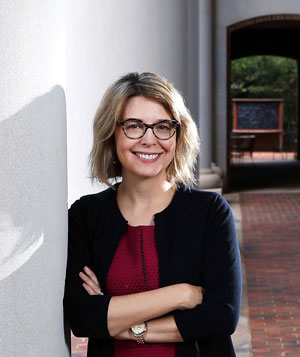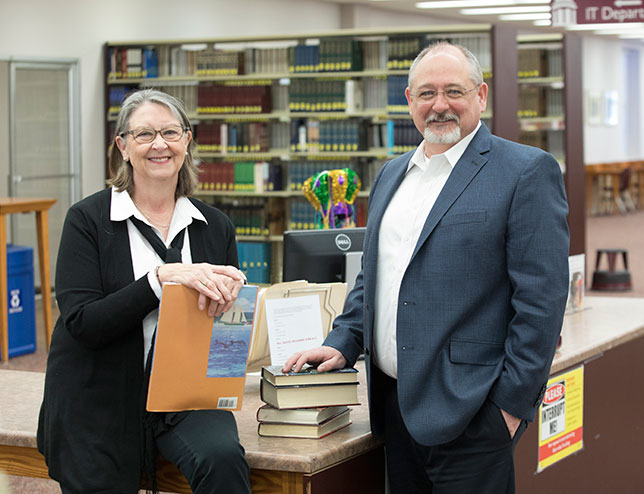Why IT and the Library Should Work Together
Higher education IT departments and libraries have long had overlapping responsibilities, yet for the most part they have remained separate entities. Could it be time for a new kind of alliance?
- By Dian Schaffhauser
- 05/09/19

Lisa Forrest
Lisa Forrest had been on the job just a week or two as the new library director at Davidson College (NC) when John McCann, manager of the User Success Team, came and asked if Forrest would be interested in piloting something new: placing student technology consultants from the Technology & Innovation (T&I) division alongside her own student library assistants. The idea was to create a blended service model in the library. Forrest, a self-professed pilot-project junkie, responded, "I don't see why not." The result: "It's added a really great energy to the library space and has made it a lot easier for our students and faculty to find research and technology help."
Of course, she added, the pilot at the North Carolina school hasn't come without its growing pains. For example, T&I consultants wore headphones and the library assistants didn't. T&I consultants were allowed to eat at their stations and the library assistants weren't. Neither group was accustomed to wearing name tags. And people who came up to the desk were confused about where to go for assistance on, say, checking out a book versus getting help with a password.
Those little issues have been resolved. (IT people still wear the headsets since they're on the phone a lot; food is eaten in a different room; everybody has matching name tags; and a designer came up with "inexpensive vinyl signage" to direct people to the correct side of the desk to get the help they want.) But more importantly, the library and the IT organization have begun developing a relationship that's uncovering new ways of working together and sorting out "areas of overlap" that can lead to better service across the board.
While Davidson's IT and library are not a merged organization and have no intentions of becoming one (CIO Kevin Davis reports to President Carol Quillen and Forrest reports to Wendy Raymond, dean of faculty), to Forrest, there's no "separating the library from the information from the technology." As she put it, "We're just stronger when we work together, period."
Fostering Communication
If Davidson could be thought of as an example of the enthusiastic early days of cohabitation, Centenary College of Louisiana in Shreveport might be viewed as a marriage that has weathered years together. There, the John F. Magale Library and IT divisions merged in 1998. Both Christy Wrenn, director of library services, and Scott Merritt, director of IT, worked at the institution when that unification took place.

Centenary College's Christy Wrenn, director of library services, and Scott Merritt, director of IT (Photo: Sherry Heflin)
Wrenn recalled the merger not as a way to curb administrative costs, but as the result of "another surge of putting libraries and IT departments together, and most of the technology at that time was in the library. That's when Centenary brought the CIO in over both of our departments to develop the technology across campus."
The primary concerns of the library staff at that time revolved around awaiting decisions about where IT was "going to live and what offices they were going to use." She can still recall the details: "They took a conference room, a lounge, a kitchen; but this only seemed challenging at first."
The IT crew, on the other hand, was delighted. "We were in the basement of the administration building," said Merritt. After the move, "Everything was much nicer."
Through the years, the merger has morphed. Both units now have their own budgets and they report to different bosses — the library to the provost's office and IT to the vice president of finance — but "structurally," said Merritt, "our working relationship with the library has not changed."
In fact, Wrenn and Merritt have offices right next door to each other, which makes for "constant communication," he noted. "It's very informal."
"We have daily meetings in the hall passing," added Wrenn.
She said she likes the way the IT team jumps to help the library's technology needs. "If we have a problem, they're right here to fix it — after I put in a work order, of course." And for his part, he said he likes how the library supported the hiring of an instructional technologist. "Her primary focus is assisting faculty with technology needs in the classroom. And she's doing that headquartered in the library."
Finding Commonalities
Forrest has seen a library merger up close. She was part of Hamilton College (NY) in 2013 when that institution brought the two organizations together to form Library and Information Technology Services (LITS). During that time, Forrest gained a "great appreciation for our colleagues in IT."
As she recalled, "Everyone just thought the IT folks just fix computers all day and librarians only help people find books. Nobody really knew all the intersections. Nobody really understood, oh, we actually have a lot in common — especially around teaching and learning."
When the education technology director retired at Hamilton, Forrest sat down with then-CIO Dave Smallen and proposed that she lead both teams. He was, she noted, "waiting" for her to suggest that.
One of the first efforts undertaken by her newly expanded team was to develop a research and design studio on the first floor of the library that brought together the librarians who were already there to work alongside two other groups: those who were education technologists and those who were part of a peer tutoring program. The idea fit well into the overall thinking for the merger in the first place, which was to develop "a shared mission for supporting students and faculty success." With her encouragement, multiple people pursued instructional design certifications either through Harvard Extension School (MA) or the American Library Association. The result was a "shared language of instructional design" as well as blended course support. The new development also led to the creation of a student-led workshop series ("Burkeshops" — named after Hamilton's Burke Library) covering 3D printing, digital media editing and design, website construction, logo design, advanced Google searching and other converged topics.
By the time she'd landed at Davidson, Forrest's initial reaction was that it felt "really foreign not be working hand-in-hand with T&I." Right away, she knew she wanted to develop "a really strong working relationship" with the CIO, Kevin Davis, and other partners in T&I. That has encompassed both organizations offering workshops on open educational resources, hosting a digital storytelling booth at "Family Weekend" and expanding shared training opportunities for Digital Media and Research Tutors. They have also joined forces to help support the college's Hurt Hub for Innovation and Entrepreneurship, where they collaborate around data literacy efforts via the Hub's weekly Data Café and ongoing workshops.
Now, Forrest is busy identifying new ways for IT and the library to collaborate. This fall, the library will introduce a new coworking space, she said, staffed by two instructional designers who will be in the library permanently, along with two research librarians "who will rotate through that space." She envisions faculty members coming to the space for help on designing assignments, which might, she offered, have both research and technology components. "We want to be able to provide assistance from the research to the creation phase of a project. We're hoping that having the different minds in the space will make that process richer and more seamless," she said.
Then there are the cross-division working groups, exploring solutions around institutional repositories, development of digital and information competencies for the college, records management and shared support of data initiatives across campus.
And what about the opportunities for those student employees to expand their information and digital competencies? Forrest has already got her eyes on some blended training they might undertake: "It'd be nice for our students to be able to offer joint workshops around topics like finding quality images for a digital project, creating visually appealing research posters or using the 3D printers." She imagines a future meeting with somebody who needs to put together a website with the help of the tech side of the house, but then, "Oh, my goodness, the images aren't cited or their resources are all from Wikipedia or there are user accessibility issues," and at that point the library side would step in to contribute.
"It goes both ways," Forrest said. "I think once people start understanding that there's so much overlap, it just gets easier. Coming here, it's clear to me you don't have to be merged to work together in meaningful ways."